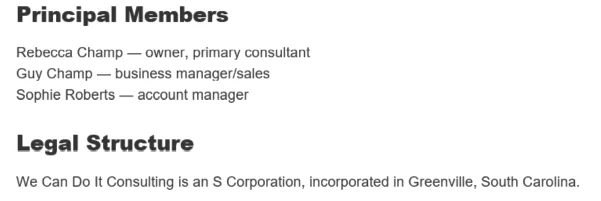- Last Updated:
- 1/30/2025
- Chelsea Ramsey, ACE CPT
Considering a new career in fitness, owning your own studio, or looking to make the jump from part-time to full-time instructor? Great!
Unsure of where to start or if your goals are realistic? No sweat!
Even if you consider yourself a trainer first and a business owner second (if at all!), a professional fitness business plan can help you analyze your options, answer the important questions, and create a roadmap for success.
How to Create Your Personal Training Business Plan
A traditional business plan consists of seven key sections that may be broken down, expanded, or combined to suit your needs.
Your personal trainer business plan may include any mix of these sections:
- Executive summary
- Company description
- Products and/or services
- Market analysis
- Marketing strategy
- Financials
- Appendix
The depth or inclusion of each section will differ based on your personal objectives and circumstances. Approach your plan with your long-term goals to ensure a clear pathway to success and growth.
Executive Summary
Your executive summary introduces your goals for starting your own personal training business. This includes your:
- Mission statement
- Elevator pitch
- Location information
- Business partners
Mission Statement
AKA your ‘why.’ Who are you helping? What goals are you helping them achieve? What do you do and why do you do it?
For example, the National Academy of Sport Medicine’s (NASM) mission statement is:
“To empower the world’s fitness professionals to change the lives of their clients through scientifically sound, evidence-based fitness and wellness practices.”
Elevator Pitch
The elevator pitch is the succinct 30-second or less summary of your business. The goal is to be as captivating yet clear as possible. The goal is to be as captivating yet clear as possible.
Example:
“Hi, I’m ____, a certified personal trainer with a passion for helping people achieve their health and fitness goals in a sustainable, enjoyable way. I specialize in helping those new to or intimidated by exercise develop fitness routines they enjoy so that they can feel more confident and in control of their health.”
Location Information
Your location refers to where you’re conducting your training. This can include online-only classes, rental spaces, and in your clients’ homes. You should also provide details about what geographic area you plan to serve.
Example from Fleet Fitness, a mobile personal training business in Alabama:
“I decided to take what I’ve learned and help Huntsville and the surrounding communities. We offer a unique fitness experience at the location of your choosing…Servicing Huntsville AL, Madison AL, Athens AL, Decatur AL, Owens Cross Roads AL, Birmingham AL, Cullman AL, Oakland AL, Tanner AL and the surrounding areas. Online personal training in Cullman AL and Oakland AL is available.”
Business Partners
If you’re working with anyone else, the business partners section is where you provide details about who they are, their roles, and their relationship to both you and the business.
Example from the Small Business Administration:


Company Description
This section will expand on the information you touched on in your executive summary.
Provide details about your ideal clientele or target demographics. Do you work with expecting parents, corporate professionals looking to compete in their first weightlifting competition, or seniors who want to maintain their functional fitness for as long as possible?
Your description should include specifics about:
- Your legal structure
- Problems you/your business solves
- What clients, communities, or businesses you plan to serve
- Your strengths, unique selling points, and any other competitive advantages
- Your business logistics, including:
- Daily operations
- Software or tech
- Scheduling
- Payments
- Health screenings
- Liability waivers
- Information management
- Communication methods and policies
- Training space
- Equipment
Products and Services
Here, you outline what you’re selling with specifics about your services (aka, personal training or nutrition coaching) and products (aka, supplements or workout gear).
Also explain how you will provide these services. For example:
- In-person
- In a rented space
- Live over video call
- Through an app
- Online with pre-recorded videos
- Online via written instruction
You may have only one primary method or service at the beginning. And that’s ok! If or when you expand your offerings you can always update your business plan, too.

Market Analysis
The job market for fitness instructors is projected to grow 14% by 2033 – significantly more than the 4% average expected growth rate for all professions. So even though the fitness industry can be a competitive one, there is still plenty of room for you to carve out your own space within it!
In your market analysis, you’ll focus on where and how you fit in the fitness industry. Consider the following questions:
- Are you filling a gap, need, or niche in your area or the health and fitness space?
- How large is your “target client” community? Locally and/or nationally?
- Where are your target clients most likely to spend their time?
- Who are your competitors?
- What do your competitors do well? What are they missing?
- How can you serve your target community better?
You’ll also provide information about your strengths, weaknesses, opportunities, and threats — also known as a SWOT analysis.
- Strengths: What are you good at? What do you do better than other trainers?
- Weaknesses: What do you struggle with? What will be a challenge for your business specifically?
- Opportunities: What openings in your market exist, and what needs aren’t being met that you plan to target?
- Threats: Things that could negatively impact you and your work, like growing competition, economic downturns, rising costs of space or equipment, and others.
A full SWOT review isn’t a requirement for your personal trainer business plan, but knowing what hurdles you could face is just as important as knowing your strengths and opportunities.
Marketing Strategy
A solid marketing strategy is how you reach your prospective clients and convert them to paying clients. You can do this in a variety of ways, depending on what makes sense for you and your business.
Channels and Platforms
These are places online or in person where you are most likely to find your clients hanging out. You can gather valuable information about where and how you should prioritize your marketing efforts by gaining insights directly from prospective customers.
Online Presence
A professional website showcases your expertise, services, contact information, and client testimonials. Social media content and activity can also help drive engagement and traffic to your website and business. Use search engine optimization (SEO) tools to increase the likelihood of your business showing up in online searches to potential clients.
Programming, Promotions, and Unique Selling Points
Building connections through networking expands the reach of your messaging and can connect you to whole new groups of potential clients or business partners. One of the best ways to get more clients is to have current ones spread the word.
You’ll learn more as you go about what strategies work for you, what doesn’t, and what costs more than it’s worth. Update your business plan as necessary to reflect these changes so you have a record of your progress.
Financials
The bottom line: finances. How are you going to make money? And how are you going to make enough money?
The financial section of your personal trainer business plan should include expectations for both the money coming in and the money going out.
Make a detailed list of all expenses, including recurring and one-off purchases. Keep in mind that these will vary depending on your business’s size and growth goals.
Expenses may include, but aren’t limited to:
- Rent or fees for gym space
- Liability insurance
- Income taxes
- Gas and/or other travel costs
- Continuing education courses
- Re-certification fees
- CPR re-certification fees
- Equipment purchases
- Internet and/or phone bills, especially if working online
A detailed revenue list may include:
- Past earnings
- Present earnings
- Training program fees
- Membership fees for remote or online programs
- Pre-designed workout plans for purchase
- Digital content, e-books, etc.
Thorough lists of past and present earnings also help you predict future earnings. The detailed comparison of your expenses and earnings illustrates your current financial status and what realistic financial goals may look like.
Plus, don’t forget to account for your expenses while determining your personal training prices!
Appendix
An appendix allows easy access to any other documents or materials you need. This is where your essential or often-cited paperwork goes, like your:
- Personal trainer certification info/ID number
- Proof of CPR/AED certification
- Proof of liability insurance
- Forms you’ll use
- Liability waiver forms
- Client health history questionnaires
- Movement screening templates
- Client programming templates
- Risk assessments
Tips for Getting Your Personal Trainer Business Started
- Take care of legal essentials: Maintain your certifications and get liability insurance (yes, personal trainers need professional liability insurance!).
- Research: Know your market, where you fit in, and potential competitors.
- Find your niche: Know what you enjoy doing, who you want to work with, and what needs in the community you’re addressing.
- Create a business plan: Create your own SMART goals for your career.
- Develop a marketing plan: Determine how you will reach your prospective clients.
- Take advantage of available tools and resources: Use apps or software designed for personal trainers for help with scheduling, programming, and payments. Check out the Small Business Association (SBA) for additional assistance programs.
Take Care of Your Clients and Yourself
Starting a business and/or a new career can be intimidating! Remember to take everything one step at a time and that you can’t help others if you’re burnt out yourself.
- Set boundaries and expectations (ex. only answer client calls/texts/emails during your business hours)
- Strive to build positive rapport with clients as people not just paychecks
- Remember to schedule time off for yourself – you’re human too!
- Offload what worries and risks you can with fitness liability insurance
FAQs About Fitness Trainer Business Plans
Is It Profitable To Be a Personal Trainer?
On average personal trainers make $46,480 to $51,270 per year, though it does usually take time to build up to a consistent client base and income.
Should Personal Trainers Have an LLC?
An LLC (Limited Liability Corporation) isn’t a necessity for personal trainers, especially if you’re working in an established gym. Trainers are typically considered sole proprietorships as soon as you conduct any business activity.
LLCs are generally designed for entities involving several people and medium- to high-risk businesses. They involve a lot more legal paperwork and are required to make Medicare and Social Security tax contributions.
Should I Include Insurance in My Personal Trainer Business Plan, and Why?
Yes.
Every exercise and fitness professional should have professional liability insurance to help protect them and their clients in the event of injuries or other accidents. Without it, trainers may be expected to pay costly medical bills or legal fees out of pocket.
Insurance is important to include in your business plan as it’s an essential factor in your finances. Plus, if you plan to grow your business or apply for loans in the future, you’ll likely need to provide proof of insurance.

Chelsea Ramsey, ACE CPT | Copywriter
Ohio-based copywriter and licensed insurance agent Chelsea Ramsey leverages her experiences as an American Council on Exercise (ACE) certified personal trainer, a role-playing game writer, and a former auto claims adjuster. She holds a bachelor’s in English from Ohio State University and a TEFL certification from Oxford Seminars. Before working at Veracity, Chelsea wrote for Zulily and trained clients at her local community center. She now writes to assist fitness professionals and entertainers in finding their ideal insurance policies.
Ohio-based copywriter and licensed insurance agent Chelsea Ramsey leverages her experiences as an American Council on Exercise (ACE) certified personal trainer, a role-playing game writer, and a former auto claims adjuster. She holds a bachelor’s in English from Ohio State University and a TEFL certification from Oxford Seminars. Before working at Veracity, Chelsea wrote for Zulily and trained clients at her local community center. She now writes to assist fitness professionals and entertainers in finding their ideal insurance policies.





